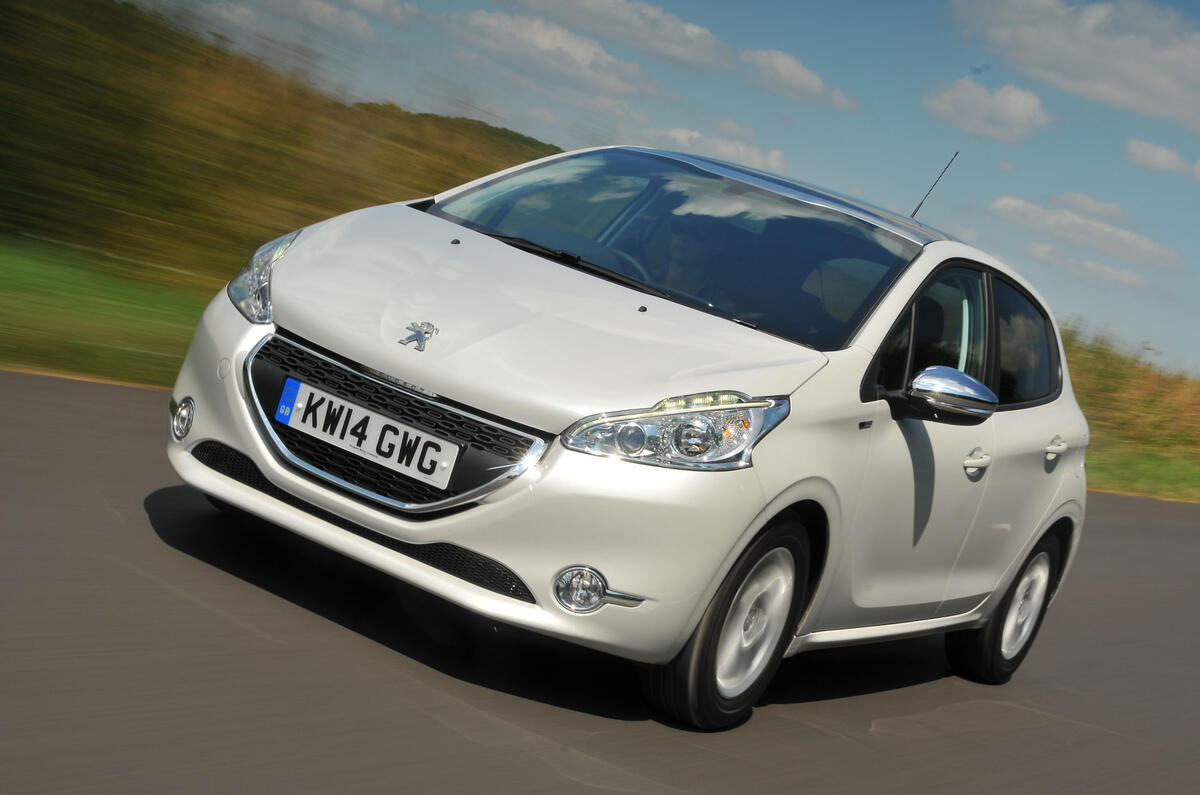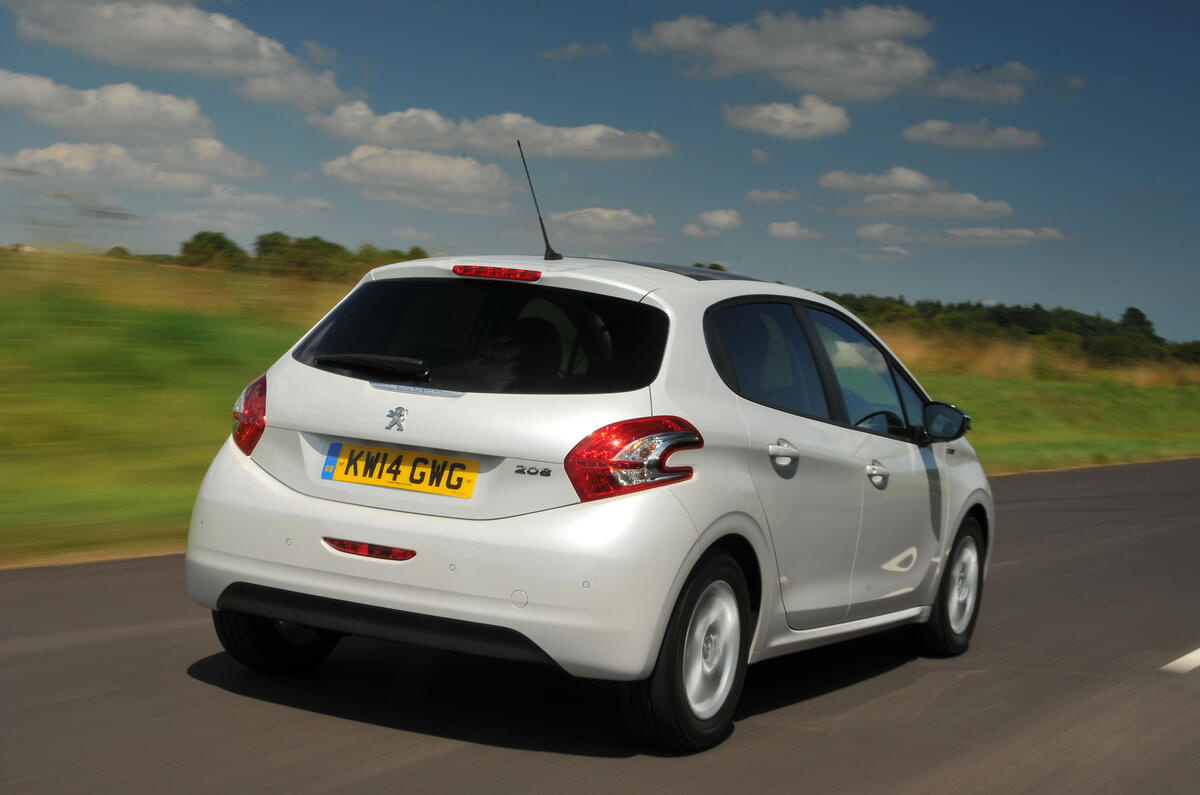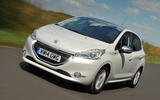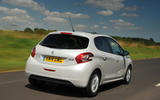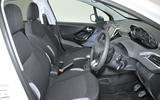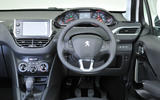Used Peugeot 208 2012-2019 review
6
Peugeot’s charming and roomy supermini can now be had for less than £1000 – should you take the plunge?


Published:
7 February 2025
- Introduction
- Reliability
- Design & styling
- Interior
- Engines & performance
- Ride & handling
- MPG & running costs
- Verdict
Find a car reviewMakeAbarthAC CarsAC SchnitzerAehraAircraft carrierAiwaysAlfa RomeoAllardAlpinaAlpineAnalogue AutomotiveArielAscariAston MartinAudiBACBentleyBeyonCaBizzarriniBMWBorgwardBowlerBrabusBristolBrookeBugattiBYDBytonCadillacCallawayCampagnaCaparoCaterhamCatonChangan AutoChevroletChryslerCitroenCooper (2001-2006)CupraDaciaDaewooDaihatsuDallaraDavid BrownDe TomasoDeLoreanDenzaDodgeDonkervoortDSDysonEagleElectrogenicElementalElfinEternitiFarbioFerrariFiatFiskerFordGBSGeelyGenesisGinettaGMCGordon Murray AutomotiveGreat British Sports CarsGreat WallGT LE50GTO EngineeringGumpertGunther WerksGWMHennesseyHiPhiHispano SuizaHoldenHondaHongqiHuman HorizonsHummerHyundaiIFRIneosInfinitiInvictaIsuzuItalDesignIvecoJaecooJaguarJannarellyJCBJeepJIAKamm ManufakturKen OkuyamaKGMKiaKimeraKingsley CarsKoenigseggKTMLadaLamborghiniLanciaLand RoverLeading EdgeLeapmotorLEVCLexusLightyearLincolnLMCLotusLucidLynk & CoMahindraMarcosMarlinMaseratiMastrettaMaxusMaybachMazdaMcLarenMercedes-AMGMercedes-BenzMercedes-MaybachMG MotorMiaMicroMikaMiniMitsubishiMitsuokaMK SportscarsMobilizeMorganMS-RTMSTMunroMurrayNextEVNioNissanNobleOldsmobileOmodaOpelPaganiPaul StephensPembleton Motor CompanyPeroduaPeugeotPininfarinaPolarisPolestarPorschePragaProdriveProtonQorosRadfordRadicalRamRed BullRenaultRevologyRevolutionRimacRiversimpleRivianRMLRodinRoeweRolls-RoyceRoverRS6 GTRufSaabSaturnScoutSeatSenovaShelbySilenceSinSkodaSkywellSmartSmit OlethaSpartan Motor CompanySpykerSRTSsangyongSSCSubaruSuperformanceSuzukiTataTeslaTheon DesignTigerTolmanToniqTouring SuperleggeraToyotaTriumphTushekTVRTwistedUniqueVauxhallVencerVeritasVinfastVolkswagenVolvoVoyahVuhlWellsWestfieldWiesmannXiaomiXpengYangwangZeal MotorZeekrZenosZenvoZolfeZoyteModel
- Introduction
- Reliability
- Design & styling
- Interior
- Engines & performance
- Ride & handling
- MPG & running costs
- Verdict
Find Used Peugeot 208 2012-2019 review deals

Other Services

The Peugeot 208 sparked a revival for the French marque in the supermini class, where it had failed to capture the attention of European buyers with its drab and dreary 207 predecessor.
Finally, here was a small Peugeot that majored on style, space and economy while also exuding a sense of desirability. It signalled a return to form for the brand whose era-defining 205 and popular 206 had historically given it the, ahem, lion’s share of the small car market.
But why opt for a Mk1 208 when there are clear class leaders in the shape of the Ford Fiesta and Volkswagen Polo? Well, start with the fact that you can pick one up for the bargain price of £800…
While the 208’s skin, cabin and engines were all-new, it inherited the 207’s dated PF1 platform, and it wasn’t the 205-emulating supermini we dreamed of in dynamic terms.
That said, the funky 208 is a far nicer car to pilot around town than its predecessor. The heft and stodge that tarnished the 207 are absent, and in most settings it rides well. It steers accurately and, even though it’s lighter than its predecessor, it’s refined and well isolated.
Sure, it can sometimes struggle to absorb medium-sized lumps and bumps, and it doesn’t offer the same level of driver entertainment as a Fiesta, but don’t let a lack of chuckability deter you from the 208.
It’s a very easy and generally comfortable car to cruise along in.
The 208 was the first Peugeot to feature the firm’s Puretech three-cylinder engines. The 68bhp 1.0-litre and 82bhp 1.2-litre units deliver on the economy front with around 45-50mpg in the real world, but their lack of gusto means they’re best suited to urban environments.
Back to top
If you want your 208 to be more of an all-rounder that can handle motorway trips, the 108bhp turbocharged 1.2-litre triple brings both economy and performance.
But while the peppy three-pot is a decent choice on the face of it, it’s plagued by reliability issues because it uses a wet belt rather than a timing chain.
The wet belt runs through the engine oil and it degrades over time, with bits of rubber clogging the oil pick-up, which causes the engine to fail.
It can also suffer from oil starvation due to faulty piston rings, which are responsible for allowing oil to pass into the cylinders. Peugeot’s parent firm, Stellantis, rolled out an extended 10-year warranty for the 1.2 Puretech, but it is subject to conditions relating to servicing.
For reference, replacing the wet belt can cost around £600.
With this in mind, we would turn instead to either the more robust 95bhp 1.4-litre four-cylinder petrol engine or the peppier, albeit slightly less efficient, 154bhp 1.6-litre turbo petrol. If you need a diesel for motorway trekking, stick with the 1.6-litre HDi.
It’s punchy and sophisticated and will return around 55mpg.
Inside, the 208 offers significantly better perceived quality and technology than the 207, with plenty of satin-finished elements, a neat-looking infotainment screen and Peugeot’s sporty i-Cockpit arrangement.
The cabin is pleasant and airy, despite some hard plastics around your knees and on the doors. And for a supermini, there’s plenty of head and leg room for adults in the front and rear.
We would put our money into an Allure, an Allure Premium or, better still, a GT-Line model as these have generous amounts of kit.
Many supermini buyers will have their minds set on front-runners like the Fiesta and Polo, but with the right engine and trim, the stylish 208 is a steal at just under £1000.
So we wouldn’t criticise anyone for taking a left-field approach and going for this keenly priced French fancy instead of the ordinary superminis we see every day.
Back to top
https://www.drivenbuy.co.uk/autocar?car_make=peugeot&car_model=208-2012-2019&review=used&source=https://www.autocar.co.uk/car-review/peugeot/208-2012-2019
Verdict

Model tested:
Rating: 6
Used Peugeot 208 2012-2019 review
An ordinary hatch that delivers on style but lacks the substance to challenge class leaders
Good
Decent interior space
Good rolling refinement
Respectable fuel economy
Bad
Sluggish performance
Perceived quality of materials
Some poor control actions
RELIABILITY
Pros
Parts are easy to source and replace
Cons
Puretech petrol is best avoided due to wet belt issues
Is the Peugeot 208 reliable?
The first-generation Peugeot 208 isn’t the mot reliable supermini floating around the classifieds. How reliable your 208 is dependent on the engine you go for, with the 1.2-litre petrol Puretech best avoided for its wet belt issues (see below).
In the What Car? reliability survery, the Peugeot 208 finished second to last in the small car class, with Peugoet as a brand coming 18th our of 31 manufacturers.
Engine: A warning light, knocking sound or fluctuating engine temperature could be a sign of engine thermostat failure. The Puretech petrol engine’s wet timing belt can fail, resulting in major engine damage. Fragments from the belt can block oil pathways, causing low oil pressure/oil starvation. Faulty piston rings can also cause oil starvation. Make sure to check the history of the car to see if the belt has been changed.
Gearbox: A spongy, loose or vibrating clutch pedal could be a sign that it’s on its way out. If it’s difficult to change gears or the clutch engages too early or too late, then the clutch might need replacing. It is recommended that the cables, hydraulic cylinders and plates are serviced regularly to prevent clutch failure.
Air conditioning: If you don’t get an icy blast from your air conditioning, this could be down to a faulty compressor, a clogged filter or a lack of refrigerant gas.
Wipers: The factory-fit wiper blades are made from hard rubber and in colder climates can judder across the windscreen when operating. Replacing these with Bosch items will solve this issue.
Boot: Talking of wipers, the rear wiper’s washer can leak water into the boot so check that the load area is dry. Also, make sure the rear hatch stays up when you open it because the struts are known to fail, causing it to shut. A new strut is the only cure
An owner’s view
Phillip Vassallo: “My family originally chose this 208 because of its low mileage and bought it so I could learn to drive an automatic. Over time, I’ve created lots of wonderful memories driving it, including many country road trips. It still has those little luxuries like leather heated seats, which now I could never give up in the wintertime. There was one frustrating point when the car spent months in the workshop because they misdiagnosed it, which ended up being spark plugs misfiring – plus a coil pack – costing around £220.”
Also worth knowing
If you like the 208’s style but want oodles of performance and genuine driver appeal, the GTi is the model of choice. Its 197bhp 1.6-litre engine (taken from the RCZ coupé) is potent and its chassis set-up makes it great fun to drive down a twisty B-road.
Provided you can live with its sedate performance, the 1.0-litre VTi costs nothing to tax, as does the 1.6-litre BlueHDi diesel.
DESIGN & STYLING
Pros
Smart and more stylish than predecessor
Leaner materials make the 208 considerably lighter than the 207
Cons
Still the same platform as the 207
Doesn’t stand out that much in entry-level trim

Despite a fresh face, name and engine line-up, the 208 wasn’t quite as new as Peugeot would have had us believe. Beneath the styling garnish was the same PF1 platform that underpinned the 207 – hence the shared 2538mm wheelbase and the familiar MacPherson strut front and rear torsion beam suspension layout.
Nevertheless, Peugeot insisted that much time and effort had been spent on improving ‘architectural performance’ and its stated goal of producing a car smaller on the outside yet larger on the inside than its predecessor should have been the aim of every supermini maker.
The most significant benefactor of the development process was the 208’s kerb weight, which, with the same, now discontinued, 1.4 HDi engine as the 207, was said to weigh 110kg less.
Peugeot claimed the entry-level model, with the three-cylinder petrol engine, clocked in at just 975kg. Our scales recorded a more substantial 1080kg, but if you consider that the 1.4 Sport we tested in 2006 was just shy of 1150kg, it was clear that some progress had been made.
Much of it could be attributed to the use of leaner materials, including high-strength steel panels and aluminium components, but the all-new three-pot engine alone was 21kg lighter than the four-cylinder unit it replaced.
The 67bhp and 81bhp versions formed the bedrock on which the rest of the carried-over range sat. Mated to a five-speed manual gearbox, it provided the 208 with a sub-100g/km starting point.
The car around it had shrunk (marginally) into its rehashed silhouette. The Peugeot 207’s bloated front overhang had been reduced by 60mm, and the rear tucked in by another 10mm.
In spite of the reduction in length, Peugeot said it had freed up an extra 50mm of legroom for rear passengers by optimising the design and installing slimmer seat backs.
INTERIOR
Pros
Spacious and practical cabin with room in the back for adults
Decent amount of boot space
Cons
Small steering wheel beneath the instrument cluster felt awkward
Rivals are of greater quality and versatility
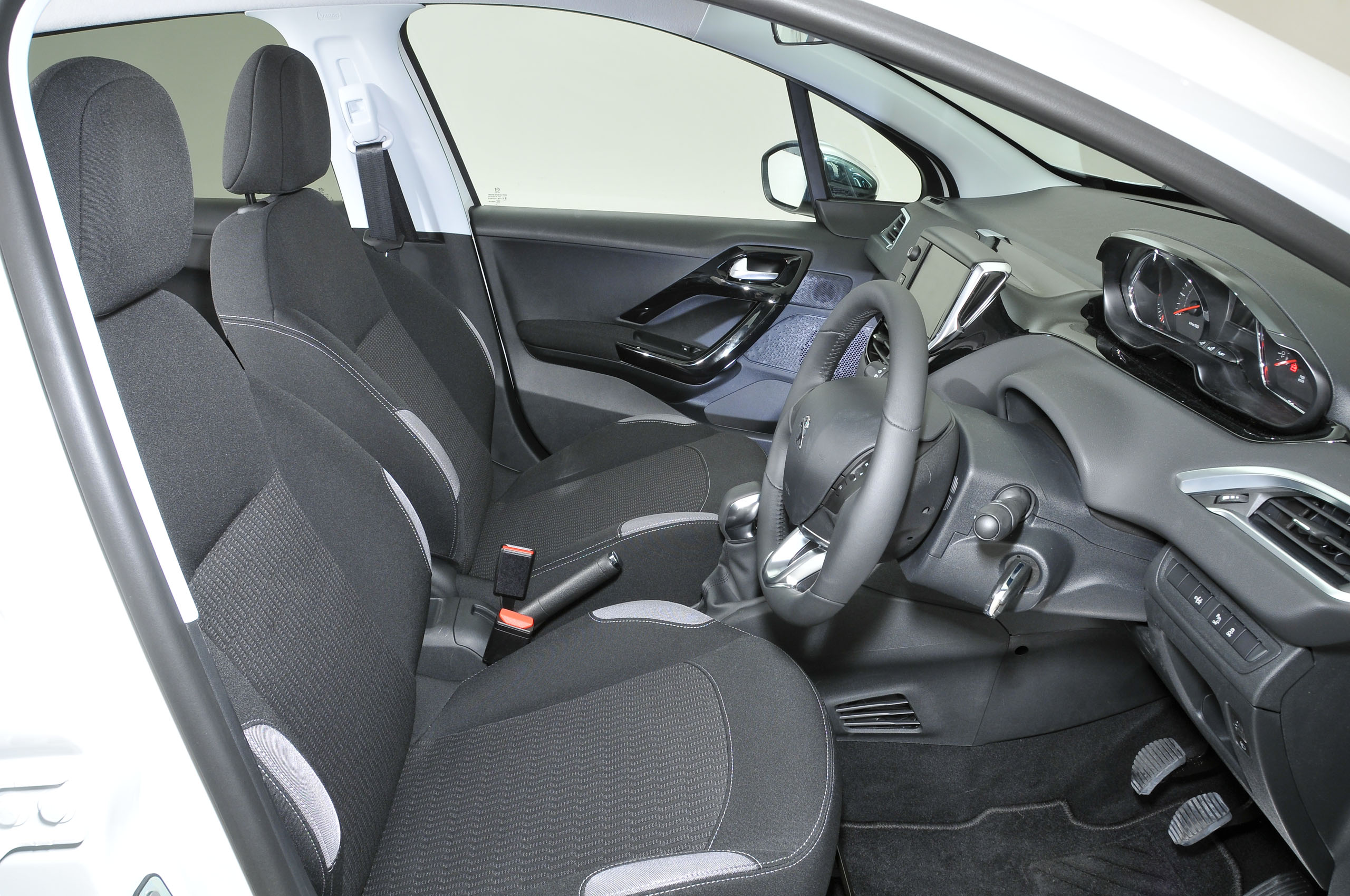
There was plentiful room in the Peugeot 208 for four adults. Indeed, it was comfortably commodious by class standards. Even putting three people in the back worked, as long as they weren’t too large and demanding.
The front seat was widely adjustable. The boot was fine by class standards, too, and you could spilt and fold the rear seats adequately. It was even a relatively interestingly designed cabin. At a cursory glance, all was okay.
The problem was that there were about a dozen superminis whose interiors were ‘okay’. There was nothing inherently wrong with that of a Seat Ibiza or a Fiat Punto, but you wouldn’t have found us recommending them on the strength of them (or much else, in their case). And the same could be said for the Peugeot.
The 208’s cabin was fine, but if you looked deeper you’d have found that it had notable failings, too. The glovebox was pitiful, and if you wanted to use a cupholder, you’d have effectively had to reach behind you.
Other features fell into the ‘good idea, but…’ category. The diddy steering wheel beneath the dials was a novel idea, but set it up for smaller drivers or those who liked a low-slung driving position and you’d have remembered why every other major manufacturer suggested reading dials through the wheel.
And although the ‘floating’ communications, audio, and navigation screen on the centre console looked slick, trying to browse through radio stations while moving at moderate speed or on a bumpy road made you crave six little preset buttons on the dashboard.
With a little finessing here and there, it all could have been so much better, living up to the promise that its design suggested it would have had.
As it was, a Volkswagen Polo’s cabin felt of higher perceived quality. A Honda Jazz’s was considerably more versatile. A Ford Fiesta’s matched it for design and, mostly, material quality, while being easier to work. The 208 was left, in this company, being moderately acceptable.
Choosing a 208 of choice was a tricky affair, as there were four core trims to choose from plus three GTi versions and a further three special edition models.
The entry-level Access trim equipped the 208 with heated door mirrors, cruise control, air conditioning, Bluetooth, and remote central locking as standard, while upgrading to Active added 15in alloy wheels, LED day-running lights, and a 7.0in touchscreen infotainment system with DAB radio and smartphone integration included.
The mid-range Allure models got a bit more chrome, 16in alloys, rear parking sensors, and automatic lights and wipers thrown in, while the range-topping GT Line gained 17in alloys, dual-zone climate control, folding door mirrors, and red stitching inside.
If you wanted a bit more power from your 208, Peugeot had three variants of the GTi, all using the same 205bhp, turbocharged 1.6-litre petrol engine.
The standard 208 GTi was adorned with 17in alloys, a rear spoiler, a chrome twin exhaust system, and leather-clad sports seats, while opting for the GTi Prestige added sat nav, heated front seats, and a panoramic sunroof.
The final variant saw the Peugeot Sport division tweaking the 208, with it rolling on 18s, with a wider front track, lower suspension, a Torsen differential, specific springs, dampers, and a wheel alignment set-up compared to the standard GTi, while inside there were Alcantara-covered sports seats.
ENGINES & PERFORMANCE
Pros
Broad mix of petrol and diesel engines
1.4-litre and 1.6-litre engines offer best performance
Cons
Not that quick despite the drop in weight
Engines lack refinement and flexibility

The entry-level model in Peugeot’s 208 range was equipped with a turbocharged 1.2-litre three-cylinder petrol engine.
Also on offer were two more powerful iterations of the 1.2-litre petrol, two 1.6-litre petrols, and frugal 1.6-litre diesels. Topping the range was the GTi model, which featured a 205bhp turbocharged 1.6-litre petrol engine.
If Peugeot’s advertised weight reduction for the 208 had led you to hope for big strides in its performance, prepare for disappointment.
At best, the mid-range 1.2-litre petrol’s performance was ordinary. At worst, in some ways, it was downright sub-standard compared with most other superminis of the same capacity and price.
That it took a full 1.5 seconds longer than a 1.2-litre Suzuki Swift to crack a standing quarter mile wasn’t a massive condemnation, the Suzuki being one of the class’s dynamic over-performers.
More serious was the lack of refinement and flexibility displayed by the engine, which was electronically restrained from a standstill when you opened the throttle wide and delivered its torque in an uneven and fairly raucous way through much of the rev range.
Worse still, whether you were bumbling along in traffic or out on your own between the hedges, the Peugeot 208 wasn’t a particularly easy or pleasant car to interact with.
Our test car had a troublesome clutch pedal with too much dead travel and a baggy manual gearchange; similar issues had dogged diesel models we had tested.
Add a small but detectable dose of driveline shunt, and the impression was of a car that felt imprecise and underdeveloped.
The 118bhp version of the motor, mated to a far superior six-speed manual gearbox, was arguably the pick of the range, but was also only available at its apex.
Far below it was the entry-level 1.2-litre variant of the three-pot engine, simultaneously appealing for its sub-100g/km CO2 emissions and virtually unpalatable for a 0-62mph time of 14 seconds.
If you were prepared to live with Peugeot’s clunky five-speed EGC gearbox, the CO2 emissions could have been lowered as far as 87g/km.
Alternatively, if running costs were less of a factor, the 160bhp 1.6-litre petrol engine had sufficient grunt to make the 208 agreeably peppy.
RIDE & HANDLING
Pros
Comfortable ride and accurate steering
Decent cabin refinement with little road noise
Cons
Not as entertaining to drive as a Ford Fiesta or Mazda 2
Rivals easier to drive due to driveline compliance

It was a particular pity that the pedal weights and shunt of the Peugeot 208 afflicted it so, because if you could have looked beyond the fact that its awkward drivetrain made progress tiring, you would have found that the rest of the driving experience was far from unpleasant.
It was far from outstanding; a Ford Fiesta had nothing to fear. At least, though, the heft that afflicted the 207 had, by and large, been banished to history.
The 208 continued, to some extent, the promising themes set out by Peugeot’s other ‘08’ models and the RCZ. It rode very well for the most part. It steered relatively accurately – albeit in an overly light fashion that was largely devoid of feel.
Its refinement was relatively strong, too; one of the most pleasing aspects of the 208 was that it had been made much lighter than its predecessor without giving much away when it came to cabin noise.
Was it fun, though? Did it feel agile? Not particularly. It would have seemed to us that Peugeot, put simply, did not think this sort of thing was important anymore.
We would have found a Ford Fiesta, Mazda 2, or Suzuki Swift more entertaining to drive. Even a Volkswagen Polo, noted for its maturity rather than its brio, was a preferable steer.
All of that was fine, as long as the car you were offering was easy to rub along with. The Vauxhall Corsa and Honda Jazz, for example, were just such cars.
Crucially, though, all of the aforementioned and more were easier to drive than the Peugeot because of their driveline compliance.



